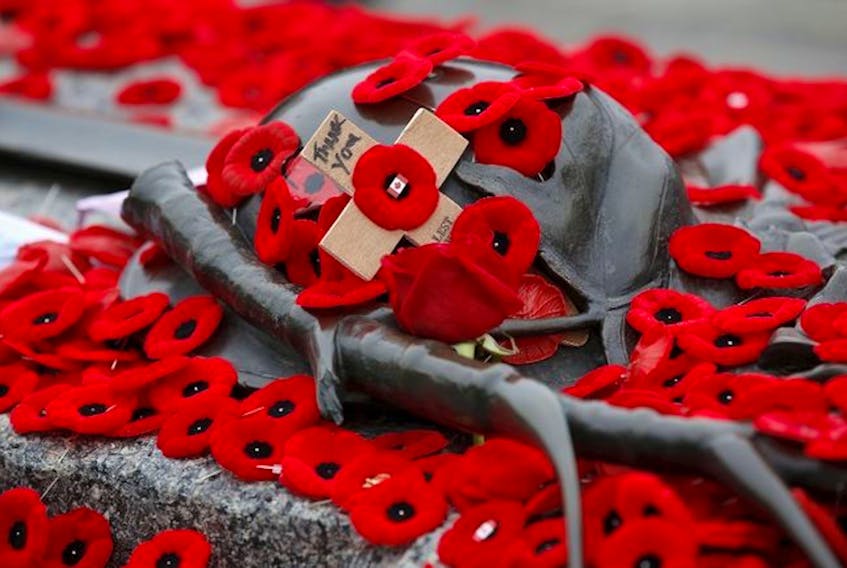November. A time when the days grow shorter, the winds colder, and the brilliant leaves of autumn have fallen.
Nestled between the spooky antics of Halloween and the season of joy, November can be a gloomy month. Still, there is one light which burns more brightly in November than at any other time of the year; it is the flame of Remembrance.
When the guns fell silent on Nov. 11, 1918, it not only signalled the end of the Great War, but forever linked this month with the sacrifice of those who fought, and often died, in the cause of freedom.
It is impossible to tell the stories of all those central Newfoundlanders lost during the Great Wars of the 20th century through anything short of a book.
In Newfoundland and Labrador, as people do worldwide, many of us quietly reflect on the sacrifice of ancestors who gave their all for the lives we take for granted. This sacrifice was very real. In the lobby of the Notre Dame Bay Memorial Health Centre hangs a tribute:
“In memory of the men from the old electoral districts of Twillingate and Fogo who lost their lives in the Great War 1914-1918.”
At the time these districts took in most of central Newfoundland, and this scroll contains dozens of names. Another World War, and the Korean Conflict, have added dozens more to our roll call of heroes.
These heroes included John Henry Simms of Fogo and Augustus Bulgin of Durrell, Twillingate. Both were awarded the Military Medal for their conduct in separate battles during 1917, though Simms died without knowing of the honour he’d received (Bulgin fell in battle the following year).
Another decorated local was Richard Edward Hynes of Indian Islands. Hynes received the Distinguished Conduct Medal for “conspicuous gallantry” at Gallipoli in 1915, but like his comrades, Simms and Bulgin, he died before the war ended.
While most of the servicemen, and women, from our area didn’t receive medals for gallantry, their service was, almost without exception, exemplary. Though many did make it home to our rocky shores, others were lost at sea serving with the Royal Navy, mown down on the Western Front in the Great War, killed in various theatres serving with the Royal Artillery in the Second World War, or died in that same conflict while attached to the Royal Air Force. Even some of those who sailed to the British Isles to serve as Foresters died in accidents or due to air raids.
It is impossible to tell the stories of all those central Newfoundlanders lost during the Great Wars of the 20th century through anything short of a book. So, in tribute to all those who served I’d like to share the story of one of our boys who faithfully fought for his country, making the supreme sacrifice.
As we do every year, this November we once again light that flame of Remembrance in their honour, with the promise that we will never forget.
Born in the mining town of Bett’s Cove, Notre Dame Bay, in 1879, Francis “Frank” Lind was working for Earle Sons & Company at Fogo when the Great War erupted. Though old enough to avoid active service, Lind selflessly enlisted with the Newfoundland Regiment a month into the War, becoming one of its first 500 recruits, the famed Blue Puttees.
During his lifetime Lind was one of the Regiment’s most famous soldiers, largely due to a series of letters sent to the St. John’s Daily News, recounting the trials and tribulations of Lind and his comrades in the Regiment. Despite the hardships suffered by these young recruits, Lind’s letters were noted for their upbeat tone, providing comfort for loved ones at home, whose thoughts were never far from those husbands, sons and fathers serving King and Country.
Perhaps the most influential of Lind’s letters home was sent from the Regiment’s camp at Scotland in 1915. Smoking was still the norm in those days, and Lind asked if his readers would send along gifts of tobacco to cheer up the troops. One of the most popular varieties was Imperial Tobacco’s Mayo Brand, and from that time on Frank Lind was affectionately known as “Mayo” Lind. Lind’s appeal resulted in six “Mayo Lind” campaigns, which raised more than $8,000 to purchase cigarettes and tobacco for the troops. Even those soldiers who didn’t smoke could trade their gifts for other comforts.
Though he was plagued by poor health from the time of the ill-fated Gallipoli campaign, Mayo Lind continued to pen his cheerful letters home through June, 1916. On the 29th of that month, he tried to describe the awful din of artillery bombardments on the Western Front, but admitted that no one who hadn’t been through it could appreciate the experience. Signing off, Lind promised his readers more interesting accounts in the days to come. They never appeared. Two days after Lind’s final letter, the Newfoundland Regiment assaulted German lines on the first day of the Battle of the Somme, an action remembered as “Beaumont-Hamel.” Like hundreds of his comrades, Mayo Lind was cut down by enemy fire, a newspaper report noting that he’d been hit in the stomach and was certainly dead.
Francis Lind was not the first casualty from central Newfoundland, nor would he be the last. As we do every year, this November we once again light that flame of Remembrance in their honour, with the promise that we will never forget.
David J. Clarke is a graduate of Memorial University's Doctoral program in history, and he is the author of eight books focusing on central Newfoundland. He can be reached at [email protected]









